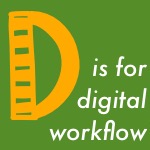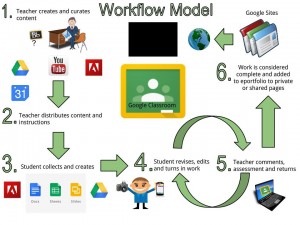Digital workflow: What is it good for?
 In its simplest form, digital workflow exchanges the paper and pencil transfer of information for a centralized digital system where information is pushed out, synthesized, analyzed, or created and returned to the teacher.
In its simplest form, digital workflow exchanges the paper and pencil transfer of information for a centralized digital system where information is pushed out, synthesized, analyzed, or created and returned to the teacher.
With the increasing popularity of 1:1 programs, or readily available access to technology, the form in which learning transfers between people, adults and students, looks slightly different than when I was in school. Additionally, the availability of free programs, such as Google Classroom, help to promote the cycle of information in an effective way.
Here’s an illustration of one workflow model, from Anthony Chuter‘s blogpost on using digital portfolios to aid learning and showcase curriculum goals (click to enlarge):
My top 10 benefits of a digital workflow system are:
- Centralized Learning – Having a place where all necessary information is contained, worked on, and submitted can help students stay organized and minimize the messy abyss we call backpacks. The days of lugging milk crates filled will essays could be gone for teachers!
- Streamlined Process – If schools adopt a work flow solution, students can work through one system rather than having a different system for each teacher they see.
- Transparency – Information, for parents, students, and teachers is easily available for access and tracking. All groups can see when, of if, work had been submitted.
- Increased Collaboration (anywhere/anytime) – This type of system can increase collaboration for learning in and out of school. Again, referring to the Google platform, student to student and student to teacher collaboration can take place regardless of the location and time of day.
- Leverage Technology – Student can choose the appropriate way in which they demonstrate their thoughts and insights. Digital systems are not limited to just text documents. Students can submit multiple forms of evidence such as videos, storyboards, and annotated pictures.
- Digital Archive or e-portfolio – Digital solutions allow work to be saved with ease. With PLP’s working in Vermont, students can choose to save their best evidence and showcase them to an audience of their choosing with the click of a mouse.
- Personalized and Interactive – Being able to push out, or share, content to specific individuals allows for a more personalized and active learning setting for students. The easy of which individualized attention can be given helps with efficient targeted feedback.
- Reporting Statistics and Monitoring – In one central place, teachers can better evaluate and plan based on formal or informal assessments.
- Changes Pedagogy – When teachers engage in a digital work flow, it promotes effective practices such as developmentally appropriate material, multiple pathways (or intelligence), Technology rich, and flexible.
- It just works -Period!
Here is one example of workflow:
Google Classroom is a great, self-contained digital workflow environment that integrates well in Chromebook and Android tablet environments, while Showbie provides a solution for iPad schools. Here’s Susan Hennessey, demonstrating what exactly Google Classroom’s digital workflow looks like in action.
Google Classroom is a great, self-contained digital workflow environment that integrates well in Chromebook and Android tablet environments, while Showbie provides a solution for iPad schools.
There are many example and platforms out there. I encourage you to try and few and use what you like. Share your favorite (or your wishlist!) in the comments.
Need to catch up on your edtech ABCs? Check out the full series here.




For the afternoon crowd, #TheABCsofEdtech continues: D is for digital workflow http://t.co/rbxIIjbUGr